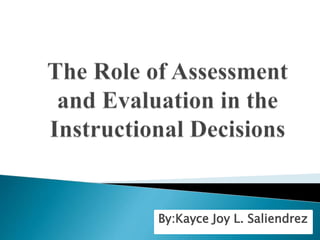
Role of Assessment in Instructional Decision -Kaye
- 1. By:Kayce Joy L. Saliendrez
- 2. Pre-instruction-(prior knowledge) During instruction-(students’ progress) Post-instruction assessment –(mastery)
- 3. Provides information about the lacking competencies such as knowledge and skill.
- 4. Monitors student’s learning Sets his teaching at a level that Challenges students metacognitive skills or high-level thinking
- 5. Monitors whether the learner mastered the basic contents ,knowledge and skills required for the learner activity
- 6. To determine the students’ entry behaviour To determine the objectives has been attained or not To determine students’ strength and weakness To rate the students’ performance for the purpose of giving grades To improve teaching-learning process.
- 7. Placement •What the students are and what they already know Diagnostic •Students' weakness for remedial instruction Formative •If instructional objectives are achieved Summative •If the students master the objectives for the purpose of giving grades Evaluation is used to determine
- 8. Placement Diagnostic Formative Summative
- 9. Used to determine the entry behaviour of the pupils Used to determine the performance at the beginning of instruction GOAL: to determine the position in instructional sequence and the mode of evaluation .
- 10. To determine the specific learning needs of the students . Strength and weaknesses
- 11. Pre-tests (on content and abilities) Self-assessments (identifying skills and competencies) Discussion board responses (on content-specific prompts) Interviews (brief, private, 10-minute interview of each student)
- 12. Assessment during the instruction Helps detect which students need attention
- 13. Observations during in-class activities; of students’ non-verbal feedback during lecture Homework exercises as review for exams and class discussions) Reflections journals that are reviewed periodically during the semester Question and answer sessions, both formal— planned and informal—spontaneous
- 14. Conferences between the instructor and student at various points in the semester In-class activities where students informally present their results Student feedback collected by periodically answering specific question about the instruction and their self-evaluation of performance and progress
- 15. To determine the mastery at the end of the course Overall assessment Achievement at the end Used to primarily for assigning course grade
- 16. Examinations (major, high-stakes exams) Final examination (a truly summative assessment) Term papers (drafts submitted throughout the semester would be a formative assessment) Projects (project phases submitted at various completion points could be formatively assessed)
- 17. Portfolios (could also be assessed during it’s development as a formative assessment) Performances Student evaluation of the course (teaching effectiveness) Instructor self-evaluation
- 18. Used to determine the effectiveness of the teacher’s method Used to give meaning to students’ effort in their quest for quality learning Used to justify the request and utilization of supplies ,materials and equipment of the schools operation
- 19. Used to plan for and improve the next educational activities Used to give recognition and awards to best-performing individual Used to promote quality assurance within and outside of the school.
- 20. https://www.azwestern.edu/academic_servic es/instruction/assessment/resources/downlo ads/formative%20and_summative_assessmen t.pdf retrieved on June 26,2014
